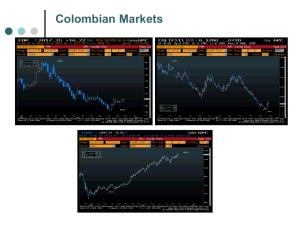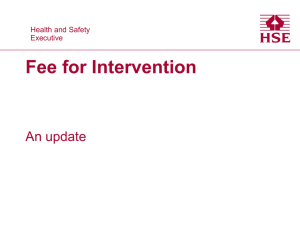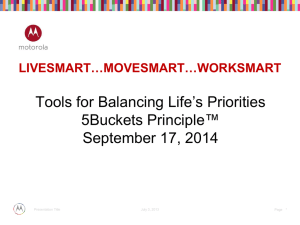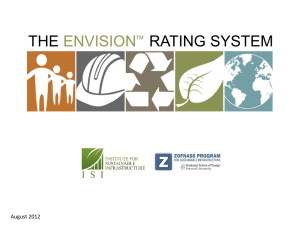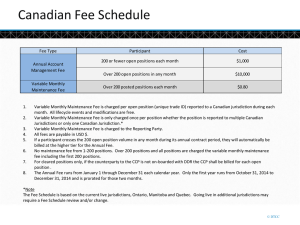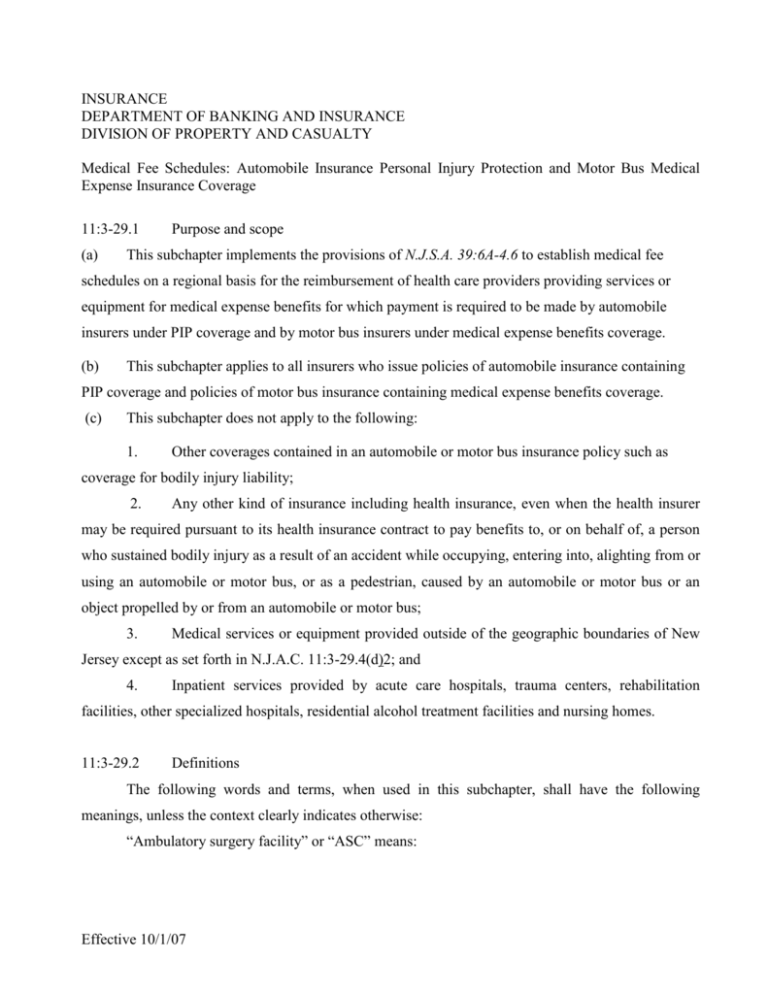
INSURANCE
DEPARTMENT OF BANKING AND INSURANCE
DIVISION OF PROPERTY AND CASUALTY
Medical Fee Schedules: Automobile Insurance Personal Injury Protection and Motor Bus Medical
Expense Insurance Coverage
11:3-29.1
(a)
Purpose and scope
This subchapter implements the provisions of N.J.S.A. 39:6A-4.6 to establish medical fee
schedules on a regional basis for the reimbursement of health care providers providing services or
equipment for medical expense benefits for which payment is required to be made by automobile
insurers under PIP coverage and by motor bus insurers under medical expense benefits coverage.
(b)
This subchapter applies to all insurers who issue policies of automobile insurance containing
PIP coverage and policies of motor bus insurance containing medical expense benefits coverage.
(c)
This subchapter does not apply to the following:
1.
Other coverages contained in an automobile or motor bus insurance policy such as
coverage for bodily injury liability;
2.
Any other kind of insurance including health insurance, even when the health insurer
may be required pursuant to its health insurance contract to pay benefits to, or on behalf of, a person
who sustained bodily injury as a result of an accident while occupying, entering into, alighting from or
using an automobile or motor bus, or as a pedestrian, caused by an automobile or motor bus or an
object propelled by or from an automobile or motor bus;
3.
Medical services or equipment provided outside of the geographic boundaries of New
Jersey except as set forth in N.J.A.C. 11:3-29.4(d)2; and
4.
Inpatient services provided by acute care hospitals, trauma centers, rehabilitation
facilities, other specialized hospitals, residential alcohol treatment facilities and nursing homes.
11:3-29.2
Definitions
The following words and terms, when used in this subchapter, shall have the following
meanings, unless the context clearly indicates otherwise:
“Ambulatory surgery facility” or “ASC” means:
Effective 10/1/07
2
1. A surgical facility, licensed as an ambulatory surgery facility in New Jersey in
accordance with N.J.A.C. 8:43A-1 in which ambulatory surgical cases are performed and which is
separate and apart from any other facility license. (The ambulatory surgery facility may be physically
connected to another licensed facility, such as a hospital, but is corporately, financially and
administratively distinct, for example, it uses a separate tax-id number); or
2. A physician-owned single operating room in an office setting that is certified by
Medicare.
“Ambulatory surgical case” means a procedure that is not minor surgery as defined in N.J.A.C.
13:35-4A.3 .
“Basic Life Support” (“BLS”) means volunteer ambulance services, whose personnel are not
required to be Emergency Medical Technicians, and municipal and proprietary ambulance services
whose personnel are required to be Emergency Medical Technicians.
“Bilateral surgery” means identical procedures (requiring use of the same CPT code)
performed on the same anatomic site but on opposite sides of the body. Furthermore, each procedure
is performed through its own separate incision.
“CDT-3” means the American Dental Association's Current Dental Terminology, Third
Edition, Version 2000.
“Co-surgery” means two surgeons (each in a different specialty) are required to perform a
specific procedure. Co-surgery also refers to surgical procedures involving two surgeons performing
the parts of one procedure simultaneously.
“CPT” means the American Medical Association’s Current Procedural Terminology, Fourth
Edition, Version 2006, coding system. Current Procedural Terminology (CPT) is copyright 2005
American Medical Association (AMA) all rights reserved. No fee schedules, basic units, relative
values, or related listings are included in CPT. The AMA assumes no liability for the data contained in
the CPT. Applicable Federal Acquisition Regulation and Defense Federal Acquisition Supplement
Regulation (FARS/DFARS), 48 CFR, restrictions apply to government use. CPT® is a trademark of
the American Medical Association.
“Eligible charge or expense” means the provider's usual, customary and reasonable charge or
the upper limit in the fee schedule, whichever is lower.
3
“Emergency care” means all medically necessary treatment of a traumatic injury or a medical
condition manifesting itself by acute symptoms of sufficient severity such that absence of immediate
attention could reasonably be expected to result in: death; serious impairment to bodily functions; or
serious dysfunction of a bodily organ or part. Such emergency care shall include all medically
necessary care immediately following an automobile accident, including, but not limited to,
immediate pre-hospitalization care, transportation to a hospital or trauma center, emergency room
care, surgery, critical and acute care. Emergency care extends during the period of initial
hospitalization until the patient is discharged from acute care by the attending physician.
“Global service” means the sum of the technical and professional components.
“HCPCS” means the Federal Center for Medicare and Medicaid Services (CMS) Common
Procedure Code System.
“Health care provider” or “provider” is as defined in N.J.A.C. 11:3-4.
“Health insurance” means a contract or agreement whereby an insurer is obligated to pay or
allow a benefit of pecuniary value with respect to the bodily injury, disability, sickness, death by
accident or accidental means of a human being, or because of any expense relating thereto, or because
of any expense incurred in prevention of sickness, and includes every risk pertaining to any of the
enumerated risks. As used in this subchapter, health insurance includes workers' compensation
coverage but does not include any PIP coverage.
“Health insurer” includes any insurer issuing a policy of health insurance as defined in this
subchapter.
“Medically necessary” or “medical necessity” means that:
1.
The medical treatment or diagnostic test is consistent with the clinically
supported symptoms, diagnosis or indications of the injured person;
2.
The treatment is the most appropriate level of service that is in accordance with
the standards of good practice and the provisions of N.J.A.C. 11:3-4, as applicable;
3.
provider;
The treatment is not primarily for the convenience of the injured person or
4
4.
The treatment is not unnecessary; and
5.
The treatment does not include unnecessary testing.
“Modifier” means an addition to the five-digit CPT code of either two letters or numbers that
indicates that a service or procedure was performed that has been altered by some specific
circumstance but not changed in its definition or code.
“Motor bus” means motor bus as defined in N.J.S.A. 17:28-1.5.
“Motor bus insurer” includes any insurer issuing a policy of insurance on a motor bus the
owner, registered owner, or operator of which is required to maintain medical expense benefits
coverage pursuant to N.J.S.A. 17:28-1.6.
“Multiple surgeries” means additional procedures, unrelated to the major procedure and adding
significant time or complexity, performed on the same patient at the same operative session or on the
same day.
Co-surgeons, surgical teams, or assistants-at-surgery may participate in performing
multiple surgeries on the same patient on the same day.
“PIP coverage” means personal injury protection coverage described in N.J.S.A. 39:6A-3.1(a),
39:6A-4a and 39:6A-10 as amended.
“PIP insurer” includes any insurer issuing a policy of automobile insurance on any vehicle that
contains PIP coverage.
“Powered traction device” means VAX-D, DRX or similar devices determined by the Federal
Food and Drug Administration to provide traction services.
“Three-digit zip code” refers to the first three digits of the U.S. postal code.
11:3-29.3
(a)
Regions
The Regions in Appendix, Exhibit 1, Physicians’ Fee Schedule, Exhibit 4, Ambulance Fee
Schedule and Exhibit 7, Ambulatory Surgical Center Fee Schedule are as follows:
1.
South Region consists of Atlantic, Burlington, Camden, Cape May, Cumberland,
Gloucester, Mercer, Monmouth, Ocean and Salem counties, which are comprised of the following
three- and five-digit zip codes in New Jersey: 077, 080, 081, 082, 083, 084, 086 and 087. The South
5
Region also includes: 08501, 08505, 08510, 08511, 08514 through 08527, 08533 through 08535,
08540 through 08550, 08554, 08555 and 08560 through 08562.
2. North Region consists of Bergen, Essex, Hudson, Hunterdon, Middlesex, Morris, Passaic,
Somerset, Sussex, Union and Warren counties, which are comprised of the following three- and fivedigit zip codes in New Jersey: 070, 071, 072, 073, 074, 075, 076, 078, 079, 088 and 089. The North
Region also includes: 08502, 08504, 08512, 08528, 08530, 08536, 08551, 08553, 08556 through
08559 and 08570.
(b)
The Regions in Appendix, Exhibit 2, the Dental Fee Schedule are as follows:
1.
Region I consists of the following three-digit zip codes in New Jersey: 080, 081, 082,
083 and 084.
2.
Region II consists of the following three-digit zip codes in New Jersey: 077, 078, 079,
085, 086, 087, 088 and 089; and
3.
Region III consists of the following three-digit zip codes in New Jersey: 070, 071, 072,
073, 074, 075 and 076.
11:3-29.4
(a)
Application of medical fee schedules
Every policy of automobile insurance and motor bus insurance issued in this State shall
provide that the automobile insurer's limit of liability for medically necessary expenses payable under
PIP coverage, and the motor bus insurer's limit of liability for medically necessary expenses payable
under medical expense benefits coverage, is the fee set forth in this subchapter. Nothing in this
subchapter shall, however, compel the PIP insurer or a motor bus insurer to pay more for any service
or equipment than the usual, customary and reasonable fee, even if such fee is well below the
automobile insurer's or motor bus insurer's limit of liability as set forth in the fee schedules. The
physicians' fee schedule at subchapter Appendix, Exhibit 1 shall not apply to trauma services at Level
I and Level II trauma hospitals. Trauma services means the care provided to patients whose arrival
requires trauma center activation or whose care requires the consultation or services of trauma service
physicians. Bills for services subject to the trauma services exemption shall use the modifier “–TS”.
Surgical services (CPT 10000 though 69999) provided in emergency care in acute care hospitals that
are not subject to the trauma care exemption shall be reimbursed at 150 percent of the physician’s fee
schedule and shall use the modifier “-ER”. Insurers are not required to pay for services or equipment
6
that are not medically necessary.
(b) The region used to determine the proper fee set forth in the schedules shall be determined by the
region in which the services were rendered or the equipment was provided or, in the case of elective
services or equipment provided to New Jersey residents outside the State, by the region in which the
insured resides.
(c)
The fees set forth in the schedule for durable medical equipment, subchapter Appendix,
Exhibit 5, are retail prices which may include purchase prices for both new and used equipment,
and/or monthly rentals. New equipment shall be distinguished with the use of modifier-NU, used
equipment with modifier-UE and rental equipment with modifier-RR.
1.
The insurer’s total limit of liability for the rental of a single item of durable medical
equipment set forth in the schedule is 15 times the monthly rental fee or the purchase price of the item,
whichever is less.
(d) The insurer's limit of liability for any medical expense benefit for service or equipment provided
outside the State of New Jersey shall be as follows:
1. When the service or equipment is provided by reason of emergency or medical necessity,
the reasonable and necessary costs shall not exceed fees that are usual, customary and reasonable for
that provider in the geographic location where the service or equipment is provided.
2. When the service or equipment is provided by reason of the election by the insured to
receive treatment outside the State of New Jersey, the reasonable and necessary costs shall not exceed
fees set forth in the fee schedules for the geographic region in which the insured resides.
(e)
Except as noted in (e)1 and 2 below, the insurer's limit of liability for any medical expense
benefit for any service or equipment not set forth in or not covered by the fee schedules shall be a
reasonable amount considering the fee schedule amount for similar services or equipment in the
region where the service or equipment was provided or, in the case of elective services or equipment
provided outside the State, the region in which the insured resides. Where the fee schedule does not
contain a reference to similar services or equipment as set forth in the preceding sentence, the insurer's
limit of liability for any medical expense benefit for any service or equipment not set forth in the fee
schedules shall not exceed the usual, customary and reasonable fee.
7
1.
For the purposes of this subchapter, determination of the usual, reasonable and
customary fee means that the provider submits to the insurer his or her usual and customary fee. The
insurer determines the reasonableness of the provider’s fee by comparison of its experience with that
provider and with other providers in the region. The insurer may use national databases of fees, such
as those published by Ingenix (www.ingenixonline.com) or Wasserman (http://www.medfees.com/),
for example, to determine the reasonableness of fees for the provider’s geographic region or zip code.
2.
All applicable provisions of this section concerning billing and payment apply to fees
for services provided outside of New Jersey and to fees that are not on the fee schedule.
(f)
The following shall apply to multiple and bilateral surgeries (CPT 10000 through 69999), co-
surgeries and assistant surgeons:
1.
For multiple surgeries, rank the surgical procedures in descending order by the fee
amount, using the fee schedule or UCR as appropriate. The highest valued procedure is reimbursed at
100 percent of the eligible charge. Additional procedures are reported with the modifier “-51” and are
reimbursed at 50 percent of the eligible charge. If any of the multiple surgeries are bilateral surgeries
using the modifier “-50,” consider the bilateral procedure at 150 percent as one payment amount, rank
this with the remaining procedures, and apply the appropriate multiple surgery reductions.
2.
There are two types of procedures that are exempt from the multiple procedure
reduction. Codes in CPT that have the note, “Modifier -51 exempt” shall be reimbursed at 100
percent of the eligible charge. In addition, some related procedures are commonly carried out in
addition to the primary procedure. These procedure codes contain a specific descriptor that includes
the words, “each additional” or “list separately in addition to the primary procedure.” These add-on
codes cannot be reported as stand-alone codes but when reported with the primary procedure are not
subject to the 50 percent multiple procedure reduction.
3.
or bilateral.”
The terminology for some procedure codes includes the terms “bilateral or “unilateral
The payment adjustment rules for bilateral surgeries do not apply to procedures
identified by CPT as “bilateral” or “unilateral or bilateral” since the fee schedule reflects any
additional work required for bilateral surgeries. If a procedure is not identified by its terminology as a
bilateral procedure (or unilateral or bilateral) and is performed bilaterally, providers must report the
procedure with modifier “-50” as a single line item. Reimbursement for bilateral surgeries reported
with the modifier “-50” shall be 150 percent of the eligible charge.
8
4. For co-surgeries, each surgeon bills for the procedure with a modifier “-62”. For cosurgeries (modifier 62), the fee schedule amount applicable to the payment for each co-surgeon is 62.5
percent of the eligible charge.
5. The eligible charge for medically necessary assistant surgeon expenses shall be 20 percent
of the primary physician's allowable fee determined pursuant to the fee schedule and rules. Assistant
surgeon expenses shall be reported using modifier -80, -81 or -82 as designated in CPT. When the
assistant surgeon is someone other than a physician surgeon, the reimbursement shall not exceed 85
percent of the amount that would have been reimbursed had a physician surgeon provided the service.
Non-physician assistant surgeon services shall be reported using modifier-AS.
6.
The necessity for co-surgeons and assistant surgeons for an operation shall be
determined by reference to authorities such as the Medicare physician fee schedule database
(www.cms.gov).
Fees for assistant surgeons and co-surgeons are not rendered eligible for
reimbursement simply because it is the policy of a provider or an ASC that one be present.
7.
It is the responsibility of providers that are acting as co-surgeons or assistant surgeons
to include the correct modifier in their bills, especially as they may not be submitted to the insurer at
the same time. If a surgeon submits a bill without a modifier and is paid 100 percent of the eligible
charge and the insurer subsequently receives a bill from a co-surgeon or assistant surgeon for the same
procedure, the insurer shall notify both providers that it has already paid 100 percent of the eligible
charge and that it cannot reimburse the co-surgeon or assistant surgeon until the overpayment has
been offset or refunded.
(g)
Artificially separating or partitioning what is inherently one total procedure into subparts that
are integral to the whole for the purpose of increasing medical fees is prohibited. Such practice is
commonly referred to as "unbundling" or "fragmented" billing. Providers and payors shall use the
National Correct Coding Initiative Edits, incorporated herein by referenced, as updated quarterly by
CMS and available at http://www.cms.hhs.gov/NationalCorrectCodInitEd/.
1.
CPT 97010 (application of hot/cold packs) is bundled into the payment for other
services and shall not be reimbursed separately.
2.
The eligible charge for an office visit includes reviewing the report of an imaging study
when the provider of the imaging study has billed for the technical and professional component of the
service. In these circumstances, it is not appropriate for the provider to bill for an office visit and CPT
9
76140 or for the physician component of the imaging study. CPT 76140 may only be billed where a
provider in a different practice or facility reviews an imaging study and produces a written report.
3.
When CPT 76005, fluoroscopic guidance, can be billed separately and is not included
as part of another procedure, it is reimbursable only per spinal region, not per level.
4.
Appendix J of the CPT manual, Electrodiagnostic Medicine Listing of Sensory, Motor
and Mixed Nerves may be used as a reference for the appropriate reimbursement of this type of
Electrodiagnostic testing.
5.
Moderate (conscious) sedation performed by the physician who also furnishes the
medical or surgical service cannot be reimbursed separately. In that case, payment for the sedation is
bundled into the payment for the medical or surgical service. As a result, CPT codes 99143 through
99145 are not reimburseable.
6.
CPT codes 99148 through 99150 are only reimburseable when a second physician
other than the provider performing the diagnostic or therapeutic services provides moderate sedation
in a facility setting (for example, hospital, outpatient hospital/ambulatory surgery center or skilled
nursing facility). CPT codes 99148 through 99145 are not reimburseable for services performed by a
second physician in a physician office, freestanding imaging center or for any procedure code
identified in CPT as including moderate (conscious) sedation.
(h)
To be reimbursable, nerve conduction studies (NCS) (CPT 95900 - 95904) must be interpreted
by a provider who was on site and directly supervised or performed the nerve conduction study in
accordance with N.J.A.C. 13:35-2.6(n)3. Needle Electromyography (EMG) interpretation must be
performed in the same facility on the same day by the same physician who performed and/or
supervised the needle EMG.
(i)
The reporting of Nerve Conduction Studies and Needle Electromyography (EMG) (CPT
95860-95872) results should be integrated into a unified diagnostic impression. Separate reports for
needle EMG and NCS are not reimbursable under the codes above.
(j)
For surgery and many other procedures, it is established practice to include follow-up care and
visits as part of the basic procedure charge. Such charges shall not be subject to additional billings.
The existence of a CPT code, per se, does not imply the right to receive separate compensation for the
procedure/sub-procedure so described. If a procedure is judged to be part of the primary procedure,
only the charges for the primary procedure are eligible. As identified in CPT, separate procedures are
10
commonly carried out as an integral part of another procedure. They shall not be billed in conjunction
with the other procedure, but may be billed when performed independently of the other procedure.
(k)
CPT codes for procedures described in CPT as “unlisted procedure” or “unlisted service”
(example: #64999 Unlisted procedure nervous system) are not reimbursable without documentation
from the provider describing the procedure or service performed, demonstrating its medical
appropriateness and indicating why it is not duplicative of a code for a listed procedure or service.
Documentation may include the existence of temporary or AMA Category III or HCPCS codes for the
procedure or information in the AMA CPT Assistant publication. In submitting bills for unlisted
codes, the provider should base the fee on a comparable procedure. It is never appropriate for the
provider to bill an unlisted code for a list of services that have CPT codes. Providers that intend to use
unlisted codes in non-emergency situations are encouraged to notify the insurer in advance through
the precertification process. Based on the information submitted by the provider, the insurer shall
determine whether the CPT coding is appropriate.
(l)
Certain CPT codes are listed in the fee schedule with three entries. There is a global fee with
no modifier, a technical component with modifier “TC” and a physician component with modifier
“-26”. Services with physician component amounts of zero in the fee schedule are considered to be
100 percent technical. A provider shall not bill the global fee and a technical or physician component.
The technical or physician component shall be billed when only that part of the service is being
provided.
(m)
The daily maximum allowable fee shall be $99.00 for the Physical Medicine and
Rehabilitation CPT codes listed in subchapter Appendix, Exhibit 6, incorporated herein by reference,
that are commonly provided together. The daily maximum applies when such services are performed
for the same patient on the same date. The daily maximum applies to all providers, including dentists.
However, when the provider can demonstrate that the severity or extent of the injury is such that
extraordinary time and effort is needed for effective treatment, the insurer shall reimburse in excess of
the daily maximum. Such injuries could include, but are not limited to, severe brain injury and nonsoft-tissue injuries to more than one part of the body. Such injuries would not include diagnoses for
which there are care paths in N.J.A.C. 11:3-4. Treatment that the provider believes should not be
subject to the daily maximum shall be billed using modifier -22 as designated in CPT for unusual
procedural services. Unless already provided to the insurer as part of a decision point review or
11
precertification request, the billing shall be accompanied by documentation of why the extraordinary
time and effort for treatment was needed.
1.
Supervised modalities and those therapeutic procedures that do not list a specific time
increment in their description shall be limited to one unit per day.
2.
CPT 97012 is the appropriate code for billing powered traction therapy.
3.
CPT 97026 is the appropriate code for billing cold or low-powered laser therapy.
4.
HPCPS code G0283 is the appropriate code for billing unattended electrical
stimulation.
5.
Pursuant to N.J.S.A. 39:6A-4, physical therapy, as defined in N.J.S.A. 45:9-37.13,
shall not be reimbursable under PIP unless rendered by a licensed physical therapist pursuant to a
referral from a licensed physician, dentist, podiatrist or chiropractor within the scope of the respective
practices.
(n)
Follow-up evaluation and management services for the re-examination of an established
patient shall be reimbursed in addition to physical medicine and rehabilitation procedures only when
any of the circumstances set forth in (o)1 through 4 below is present and not more than twice in any
30 day period. Modifier -25 shall be added to an evaluation and management service when a
significant separately identifiable evaluation and management service is provided and documented as
medically necessary as follows:
1.
There is a definite measurable change in the patient's condition requiring significant
change in the treatment plan;
2.
The patient fails to respond to treatment, requiring a change in the treatment plan;
3.
The patient's condition becomes permanent and stationary, or the patient is ready for
discharge; or
4.
It is medically necessary to provide evaluation services over and above those normally
provided during the therapeutic services.
(o)
ASC facility fee group numbers are indicated by CPT code on the physician’s fee schedule,
subchapter Appendix, Exhibit 1. The facility fees for each ASC group are listed in subchapter
Appendix, Exhibit 7. If a procedure can be performed in an ASC but it is not listed in the physician’s
12
fee schedule, the ASC facility fee for the procedure shall be the fee group in Appendix, Exhibit 7 that
includes procedures similar to the unlisted procedure. For example, if an injection code is not included
in Appendix Exhibit 7, the facility fee for the procedure would be the same as for other injection
codes that have a group number. In no case, shall a facility fee be greater than the highest facility fee
on the schedule (Group 9). If a CPT code is subsequently assigned an ASC group number by
Medicare, as found in http://www.cms.hhs.gov/ascpayment/, the facility fee for that code shall be that
of the same group number in Appendix, Exhibit 7. The ASC facility fee includes services that would
be covered if the service were furnished in a hospital on an inpatient or outpatient basis, including:
1.
Use of operating and recovery rooms, patient preparation areas, waiting rooms, and
other areas used by the patient or offered for use to persons accompanying the patient.
2.
All services and procedures in connection with covered procedures furnished by
nurses, technical personnel and others involved in patient’s care;
3.
Drugs, biologicals, surgical dressings, supplies, splints, casts, appliances, and
equipment;
4.
Diagnostic and therapeutic items and services;
5.
Administrative, recordkeeping, and housekeeping items and services;
6.
Blood, blood plasma, platelets, etc.; and
7.
Anesthesia materials, including the anesthetic itself, and any materials, whether
disposable or re-usable, necessary for its administration.
(p)
The following services are not included in the ASC facility fee:
1.
The sale, lease or rental of durable medical equipment (DME) to ASC patients for use
in their homes. If the ASC furnishes items of DME to patients, billing for such items should be made
in accordance with subchapter Appendix, Exhibit 5; and
2.
Prosthetic and other devices, including neuro-stimulators, internal/external fixators,
tissue grafts, plates, screws, anchors and wires, whether implanted, inserted, or otherwise applied by
covered surgical procedures. Such prosthetics and devices shall be billed at invoice plus 20 percent.
(q)
When multiple procedures are performed in an ASC in the same operative session, the ASC
facility fee for the procedure with the highest payment group number is reimbursed at 100 percent and
reimbursement of any additional procedures furnished in the same session is 50 percent of the
applicable facility fee. For example, if two Group 2 procedures and a Group 1 procedure are all
13
performed in the same operative session, reimbursement of the ASC facility fee is 100 percent of the
first Group 2 fee plus 50 percent of the second Group 2 fee, plus 50 percent of the Group 1 fee.
11:3-29.5
Balance billing prohibited
No health care provider may demand or request any payment from any person in excess of those
permitted by the medical fee schedules and this subchapter, nor shall any person be liable to any
health care provider for any amount of money that results from the charging of fees in excess of
those permitted by the medical fee schedules and this subchapter.



